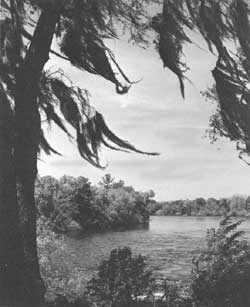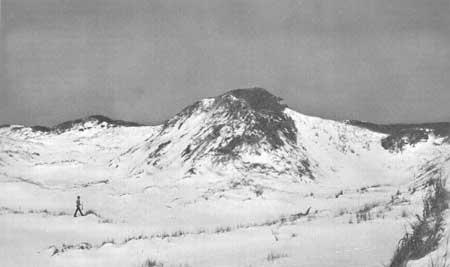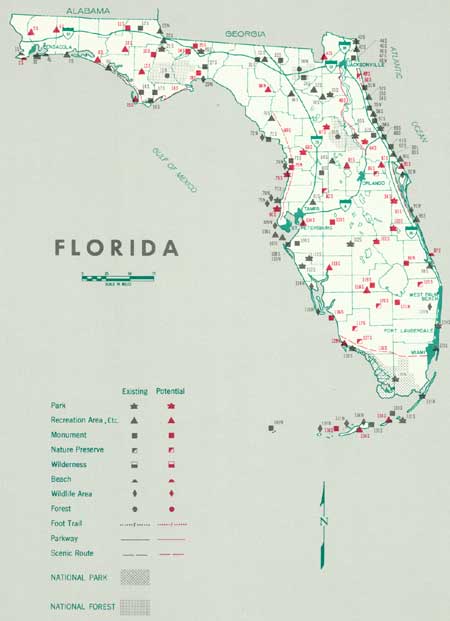.gif)
Parks for America
MENU
|
Parks for America
|

|

|
| The Suwannee River in Florida, a free-flowing stream whose outstanding natural values make it worthy of consideration for national river status. |
FLORIDA
FLORIDA has an Atlantic and gulf coastline of 8,426 miles and a warm winter climate that has made it one of the Nation's leading recreation States.
Florida's population increased 78.7 percent during the 1950—60 decade, to reach 4,951,560. Seventy-three percent of the population is urban. The average density was 91.3 persons per square mile. Eleven counties had a density of less than 10 persons per square mile. Projections indicate a population of 8,387,000 by 1976.
The tourist industry is a major industry in Florida with a 1960 value of $1.8 billion for 11 million visitors. The tourist season is year round, with summer and winter months showing peak visitation.
Eighty-one percent of out-of-State visitors enter the State by automobile and use their cars to visit outdoor recreational areas. The extreme southern section of the State will benefit most when the Interstate High way System is completed. Driving time from out-of-State points will be reduced, thus increasing the number of visitors to the southern portion and allowing visitors more time in Florida for recreation.
The climate ranges from temperate to subtropical. The winter months are warm, with abundant sunshine. Summer temperatures are in the 90's, tempered by rain and cool nights. The upper Atlantic and gulf coast regions receive their heaviest visitation during the summer season.
Major recreation resources are the fine beaches; many fresh-water lakes, including Lake Okeechobee; scenic rivers; the 2,500,000 acres of open marshlands in the Everglades; the largest known limestone springs in the United States; the Intracoastal Waterway; the Florida Keys with coral reefs; and myriad ponds, marshes, and tidal lagoons. Forests cover much of Florida, which has 3,000 species of native flowering plants and abundant wildlife. Inshore and deep-sea boating and sport fishing are outstanding recreational activities.
Despite the State's rapid growth, ample wild country and unspoiled shorelines are still available.
The State is rich in historic and prehistoric sites. In addition to sites in the National Park System, there are four sites that possess exceptional value in commemorating the history of the United States.
It is important to the tourist industry that sufficient public outdoor recreation areas are created to preserve the recreation resources of the State.
The rivers, streams, marshes, and Everglades areas are seriously threatened by rapid urbanization, industrial development, and other activities.
EXISTING PUBLIC AREAS
NATIONAL: The National Park Service administers one national park, two national memorials, and three national monuments, with a total of 1,348,864 acres. The 1960 attendance was 1,109,332. The Forest Service administers 40 recreation areas and 4 game management areas in 3 national forests amounting to 1,074,972 acres. The attendance at these forests was 1,205,000 in 1960. The Bureau of Sport Fisheries and Wildlife administers 262,024 acres in 14 national wildlife refuges. There is one Corps of Engineers' reservoir with 40,300 acres of water, partly in Alabama and Georgia. The 1960 attendance was 1,004,000.
STATE: The Florida Park Service has 57 parks, monuments, and recreation areas, with a total of 120,803 acres and having a 1960 attendance of 3,195,136. The Florida Game and Fresh Water Fish Department has 2 refuges and 32 wildlife management areas with 114 boat ramps. The Florida Forest Service has four forests with six recreation areas. The Florida Road Department provides 225 roadside parks and 97 boat ramps.
LOCAL: Dade County administers 47 parks totaling 3,650 acres. There are 1,930 acres in 6 other local areas.
PRIVATE ENTERPRISE: Private enterprise plays a major role in providing recreation facilities such as marine gardens, marine aquariums, natural spring developments, beaches associated with resorts and hotels, marinas and sport fishing boat facilities. They are extensively advertised and open to the public.
Four million acres of privately owned forest lands are open to public hunting under State game management control and supervision.
PARK AND RELATED NEEDS
There is immediate need for action to preserve and develop for public use the remaining unspoiled beaches, free-flowing streams, lake shorelines, and other natural scenic, historic, and scientific resources.
Existing State recreation areas now provide 120,800 acres for the 4,951,600 residents. Potential areas of State significance identified in this plan total 100,400 acres, which is considered adequate for present population but far short of probable need by 1976.
No potential local areas have been identified. Some urban centers have extensive recreation developments, but still have not been able to keep pace with the population increase. There is an urgent need to provide close-by recreation areas for urban residents.

|
| St. Joseph Spit in Floria is a Cape Cod in miniature. High dunes, beaches, forests, and wildlife make it an important recreation resource. |
RECOMMENDATIONS
Existing recreation resources and many potential areas are shown on the accompanying tabulation and map. Vigorous action on a program suggested by the following recommendations can do much to provide needed additional outdoor recreation opportunities for public enjoyment in Florida.
NATIONAL: Studies looking toward the possible establishment of a Suwannee National River, a Marco National Seashore, an Okeechobee National Battle field, and a Chassahowitzka Springs National Monument.
The Suwannee River in Florida, a free-flowing stream whose outstanding natural values make it worthy of consideration for national river status.
STATE: Expansion of the State park system to protect valuable resources and provide additional recreation opportunities by addition of five parks, eight monuments, six recreation areas, three nature preserves, and two beaches. Further study of three other parks, eight recreation areas, four nature preserves, and two monuments.
Consideration of designating and protecting five scenic routes, and the acquisition of lands and construction of a State parkway along the St. Johns River.
Supporting recommendations include—
1. Continued coordination between the U.S. Corps of Engineers and interested State and local conservation and flood-control districts to provide recreational facilities on existing and proposed impoundments.
2. Expansion of the staff of the State park authority to provide technical park planning assistance to political subdivisions of the State.
3. Study of the feasibility of establishing a State geological park in the phosphate mine section to preserve and interpret State geology and the story of prehistoric mammals.
(Table omitted from online edition)

|
| (click on image for an enlargement in a new window) |
NEXT >>>
|
|
Last Modified: Mon, Sep 6 2004 10:00:00 pm PDT
parks_america/florida.htm
 Top
Top